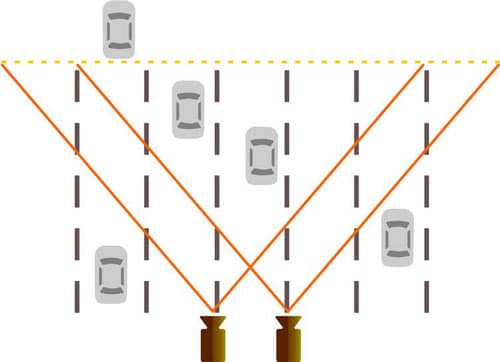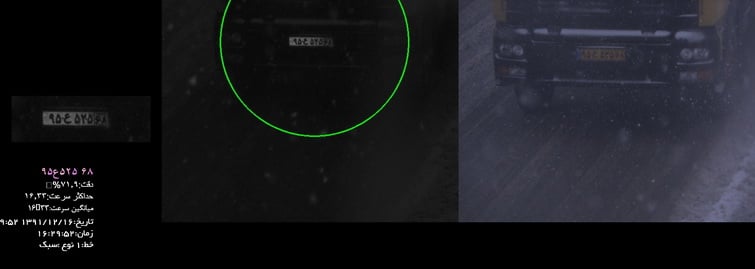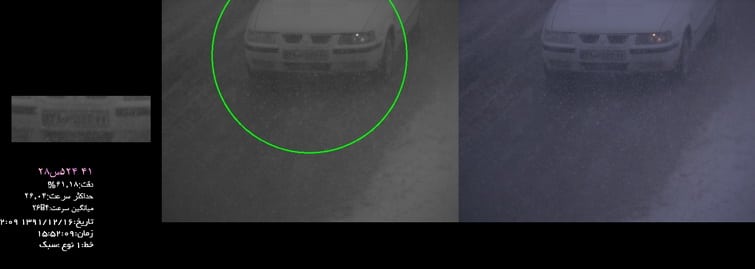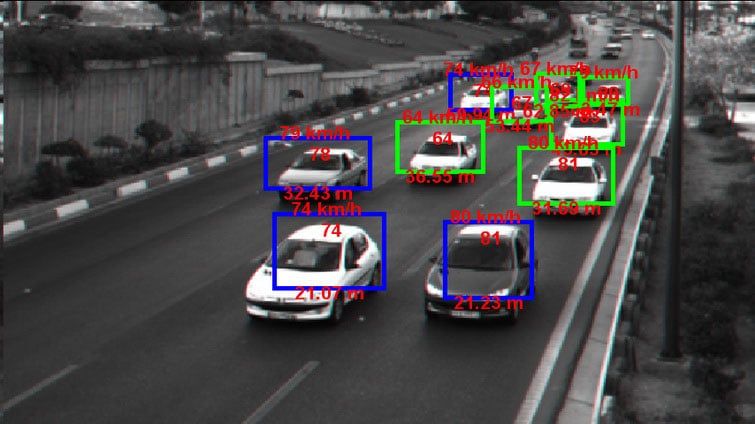SPEED EXTRACTION
Since it is known, for determining the speed of moving object in 3d space the ratio of position change to time change will be used. Then continues 3d positioning of an object is obvious prerequisite for detecting object speed, and for extracting position several technologies such as laser, radar and vision is being used. In our offered system, stereo vision (using tow calibrate camera) technique utilized for measuring passing vehicles speeds.
For each frame of the tow cameras streams, depth measurement procedure will be take place as obtaining parallax of each pixel of tow image as disparity. Then with utilizing some geometric and filtering mathematics and sophisticated image processing algorithms, first distance then accurate speed of each vehicle in the scene will be extracted.
Road Independent
For accurate speed measurement, knowing relative position of object is needed. For this purpose some other system are highly dependent on the geometry of road relative to them, For example cannot use them in Curvature road. And some of these systems mark on the road to maintain their relative calibration valid. But given that this product is based on stereo vision and main calibration is inside of system in one hand and on other hand has the ability of distance measurement for any object in 3d space, the speed accuracy of the system is independent of the road shape and has no need to mark the road.
Speed For Plateless Cars
Another important and distinct difference between this system and some other vision based system is that some of them use license plate image for detecting and speed extraction of vehicles. In these systems measuring the speed of the cars is highly dependent on the finding license plate because the displacement of the car is measured based on movement of plate in corresponding sequential images. And so as there is a relatively great probability of loosed plate (damaged, cars with No license plate, unstandardized plate format or engine error) this systems have intensive weakness in their nature. Another problem of such products is relatively low accuracy in speed extraction due to influence of mounting place of license plate.
Since our product use all of a vehicles path in three-dimensional space for measuring speed, has no dependence on plate and speed of all type of vehicle with or not with license plate, damaged or unstandardized plate will accurately calculated.
Speed Precision
This product currently is being used operational in Iran‘s roads. And up to now police department test More than 10 thousand passing vehicles to ensure about the accuracy of systems in various conditions. As result of these tests the average error of speed measurement confirmed that is less than one percent and maximum error founded is 4%. In these tests tow device utilized: GPS and Laser gun.
To test the system with GPS, a high data rate GPS module install in a car and it passes through system speed detection range. The GPS data logged with a very precise time as well as the location, comparing these data with the system data results to system accuracy.
A laser gun system which is equipped with a camera to log the passing vehicles images (and films) with their speeds and distances ( from the laser gun, as they are in the predefined range). Comparing these data with the fixed speed camera data results to system accuracy.
Tracking All Vehicles
In continuous long time field test, missed cars were less than 2% .
Wide Imaging
As wide view angle imaging sensors used for vehicle detection and speed extraction, therefor there is no exact limit for number of lanes and only with some optical device changes 6 (and even more) lanes can be covered.
Unsuitable Weathers
This fixed speed camera has been operationally utilized in mountainous and desert roads. In all weather conditions it has been worked well. As you see its results in heavy snowfall and blizzard conditions.
Speed Extraction Range
As wide optical lenses for imaging sensors have been used in this fixed speed camera for vehicle detection and recognition, it has a deep and vast view of the road. This well imaging capability make this system capable of detecting vehicles body and speed from more than 100 meters. Such deep detection and speed extraction range increase the speed metering precision and decrease missing possibility with respect to the systems which measuring speed in short ranges.
Speed Extraction Limit
As in this system imaging and stereo processing perform with high rates, it can detect vehicles with high speeds. In field test it has been detected cars with speeds up to 230 km/h (where the situation only allows that much of speeds) . But also in laboratory simulation it has been past the tests for speeds up to 400 km/h.
Heavy or Light Classification
Considering traffic rules and limitations are different for light and heavy vehicles, separating these two classes of vehicles is mandatory. As in this speed camera vehicles are detecting, tracking, and recognizing in 3D space therefor their dimensions are known and it can categorizing light and heavy vehicles. Also considering that in Iran (and some other countries) license plates are not designed separately for light and heavy vehicles such classification can be very useful.
Overlapping Resistance
As in this speed camera wide imaging system is utilized for detecting and recognizing vehicles, the sensitivity to overlapped cars falls dramatically. In fact as much as the vehicles are detectable from both stereo cameras point of view, they would be recognized.
Calibration
As this speed camera utilizes stereo processing technology for speed metering, the accuracy is directly related to stereo calibration. This point is elegantly considered in design, therefor calibration process only need to be performed once in the laboratory and then it would be installed in the box. This will reduce calibration procedure in setup site.
Passing Lane Detection Recognition
Since traffic rules and limitations are dissimilar for different lanes, detecting passing lane is necessary. As in this speed camera stereo processing technology applied, 3D location of vehicles can be driven in road coordinates. Therefor determining passing lane and solid line crossing violation detection cab be performed.
Approaching or Receding
This fixed speed camera track and recognize all passing vehicles in its detecting range regarding of approaching/ receding direction. In Iran as the police requested it is working for approaching cars.
Car Shape Independent
Insomeother vision based systems, shape and geometric propertiesof a car is used for detection and separating it, asitisassumed that a car shape is like square or other assumption and It is obvious that these assumptions may lead to errors in the system. But in our system thanks to strong stereo vision based algorithms, any object and his 3D diminutions and velocity will be calculated and this bring the ability of working with Largetrucks or motorcycle like a usual passenger car at the same time and even separating vehicles with partialoverlap.














